Structure of DNA
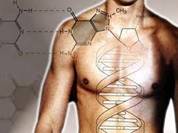 Nucleic acids are biological macromolecules present in all living organisms. These biological molecules are essential for life, and include DNA (deoxyribonucleic acid) and RNA (ribonucleic acid).
Nucleic acids are biological macromolecules present in all living organisms. These biological molecules are essential for life, and include DNA (deoxyribonucleic acid) and RNA (ribonucleic acid).
These are responsible for the storage and transfer of genetic information from generation to generation. Friedrich Miescher, a Swiss biochemist (1869) was the first to isolate nucleic acids from the nucleus of pus cells and Salmon sperm. He called it “nuclein”. Altman (1899) coined the term “nucleic acid”.
Deoxyribonucleic acid (DNA)
Occurrence:
DNA found in all organisms except a few viruses. The greatest amount of DNA is concentrated in the nucleus. It also occurs in cell organelles like mitochondria, plastids and centrioles.
Chemical Composition:
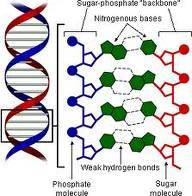
Deoxyribonucleic acid is a polynucleotide molecule consisting of a repeating sequence of monomeric nucleotides arranged in a linear polymeric chain. Each monomeric nucleotide is composed of three components.
i)A five carbon (pentose) sugar – Deoxyribose
II)A phosphoric acid group
III)A nitrogenous base (either purine or pyrimidine)
Purine bases are adenine and guanine. Pyrimidine bases are thymine and cytosine. The pyrimidine uracil is absent.
Adenine pairs with thymine by two hydrogen bonds. Cytosine pairs with guanine by three hydrogen bonds.
DNA – Double Helix
J.D.Watson and F.H.C. Crick in 1953 proposed the double helix model of DNA based on Chargaff’s analytical data and the X-ray diffraction studies made by M.H.F Wilkins and Rosalind Franklin. They were awarded Nobel prize in 1962 for this work.
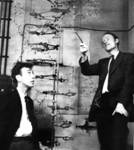
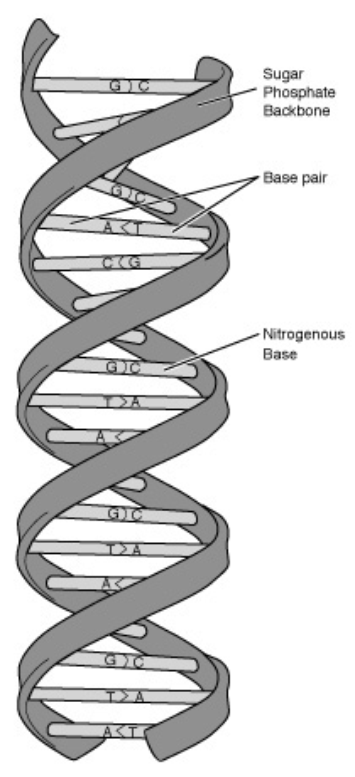
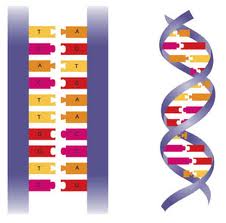
The features of Watson and Crick model of DNA are:
1.DNA is composed of two helical polynucleotide chains that are coiled around a common axis forming a double helix (usually right-handed) resembling a spiral staircase.
2.The sugar phosphate units of the nucleotides form the backbone and the nitrogenous bases form the cross rungs of the DNA molecule.
3.Nucleotides of a strand are linked to each other through phosphor-diester bonds between the sugar of one nucleotide and the phosphate of the other nucleotide.
4.The two strands of the DNA molecule are held together by the hydrogen bonds formed between purine and the pyrimidine bases. The base pairing is specific. Always adenine pairs with thymine and guanine pairs with cytosine. This is known as complimentary base pairing. Due to this the two stands of the DNA are complimentary and not identical.
5.The amount of purines and pyrimidines are always equal (A+G=C+T). The amount of adenine is equal to the amount of thymine and the amount of cytosine is equal to guanine. This is Chargaff’s rule of base equivalence. The ratio A+G/T+C is always a unity.
6.Number of hydrogen bonds is specific. There are two hydrogen bonds between A and T and 3 hydrogen bonds between G and C (A=T and G=C).
7.The two strands are anti parallel. ie. One of them runs in 5’ to 3’ direction and the other runs in 3’ to 5’ direction.
8.The diameter of the DNA molecule is 20 A (2nm). One full turns of the double helix (one gyre) takes 34 A (3.4nm) and has 10 base pairs. One base pair is placed at an angle of 36 degrees with reference to the next base pair. The distance between the two adjacent base pair is 3.4 A degree.
9.The double helix has two grooves namely major deep groove and minor shallow groove. They alternate each other. In these grooves specific proteins interact with DNA molecule.
Functions of DNA
1.DNA is the genetic material in most of the organisms except a few RNA viruses, controlling the structure and function of an organism.
2.DNA is capable of self replication or duplication and passes on the hereditary characters to the next generation.
3.DNA undergoes mutation and genetic recombination.
4.DNA synthesizes RNA.
5.DNA sends coded information for protein synthesis. The proteins control the structure and function of the cells.
What is the difference between a DNA and the RNA?
Want to know more about DNA structure? Click here to schedule a live help with an eTutor!
About eAge Tutoring
eAgeTutor.com is the premium online tutoring provider. Using materials developed by highly qualified educators and leading content developers, a team of top-notch software experts, and a group of passionate educators, eAgeTutor works to ensure the success and satisfaction of all of its students.
Contact us today to learn more about our guaranteed results and discuss how we can help make the dreams of the student in your life come true!
Reference Links:
- http://en.wikipedia.org/wiki/Nucleic_acid
- http://en.wikipedia.org/wiki/RNA
- http://en.wikipedia.org/wiki/DNA
- http://en.wikipedia.org/wiki/Nucleic_acid_structure
- http://www.youtube.com/watch?v=qy8dk5iS1f0